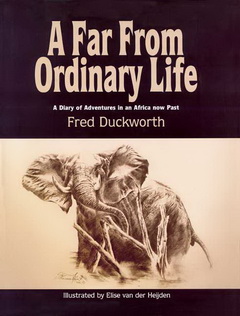| |
|
|
Libros - Mundialmente - A FAR FROM ORDINARY LIFE
Duckworth, Fred
| Producto: |
«» |
 |

|
Precio: EUR 62,06
2004 Johannesburg, 244pp, photos ISBN: 0-9584590-3-7 Encuadernación: Trim Size: 8 x 11, hardcover with dust jacket |
|
|
The story begins with Fred’s birth in “old colonial-style” Calcutta to British parents in 1934 during his father’s fifteen-month shikar there to hunt big game. His father’s work as a civil engineer with the East African Rails & Harbours placed the family in the middle of Kenya elephant country—the ultimate “being at the right place at the right time with the right people.” With his .470 Nitro Express in hand, he took his son in pursuit of worthy tuskers and, later, tiger and markhor on the subcontinent. Fred’s first elephant (carrying 89 and 81 pounds of ivory) was taken with a 9.3x64mm Brenneke Mauser, which quickly taught him a good lesson: to carry as big a double rifle as possible, a .470, for the rest of his hunting career.
Fred’s hunting career nearly came to an end when he was shipped off to Great Britain for the sake of an education and when he learned his father had drowned while hunting elephant in southeastern Tanganyika. Devastated that his mother had sold her husband’s guns, he embarked, at age eighteen, on life with his father’s all-important last real gift, a .375 H&H Magnum Mauser.
Fred’s descriptive prose vividly brings to life his wanderings and twists of fate as he evolved from his early years assisting game-control scouts in the Selous Game Reserve in Tanganyika to becoming a licensed professional hunter. Along that path in his long career he hunted for ivory at a time when a 110-pound per side tusker was worth four-month’s pay as an assistant game ranger, and he describes the personalities, guns, and game encountered.
In a feat that would be impossible today, Fred’s perpetual lucky streak landed him highly coveted “real jobs” that led to great adventures. As regional game warden of Nyasaland, he was called in to hunt down thirteen man-eating lions, including the notorious Kasupe lion that had killed seventeen women, nine men, one child, and had mauled another eight people.
We find Duckworth in 1972 in the Coptic Christian Empire of Ethiopia, where he was responsible for “reorganizing” the barely existing big-game hunting safari industry. In the meantime, in the Danakil he met his future wife—the beautiful, adventurous Dutch artist, Elise, who thirty-some years later remains at his side.
Fred takes us through the entire evolution of Ethiopia’s safari industry, which began in the 1950s with a Russian Turkish lady named Marusa Lapin and her husband, Yura. At that time the safari industry in Ethiopia consisted of conducting a few hunts in the Arusi Mountains for mountain nyala. As the safari industry began to evolve, an American schoolteacher, Ted Shatto, who is remembered for taking James Mellon on safari, set up camp in Ethiopia. Then more professional hunters came to Ethiopia: Karl Luthy, Col. Negussie Esthete, Carl Forsmark, Maj. Gizaw G. Giorgis, Dimistris Assimacopoulos, Nassos Roussos, Thomas Mattanovich, and Hakan Pohlstrand. This is an interesting story on parts of Africa not many others have ventured to so not much has been written about.
A Rowland Ward Publication |
 |
| Producto: |
AnteriorSiguiente |
|
|






















